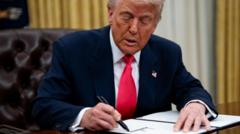President Trump has taken a bold step by signing an executive order to dismantle the Department of Education, a fulfillment of his campaign promise heavily favored by conservative supporters. During the signing event, Trump denounced the department for what he described as "breath-taking failures" and asserted that funding allocated to it should be redirected back to the individual states.
"We're going to shut it down as quickly as possible," Trump proclaimed, although White House officials clarified that this action would require Congressional approval. Facing impending legal challenges, this order has already ignited robust opposition from various stakeholders, including educators and advocacy groups, who contest the detrimental implications of such a drastic decision.
Despite misconceptions surrounding the department's role, most public schools are primarily funded through state and local taxes, with federal contributions accounting for only about 13% of total funding. Established in 1979, the department plays a crucial role in administering federal student loans and offering support for economically disadvantaged students. Trump's critique points to the agency's influence on school curriculum, accusing it of promoting divisive concepts related to race and sexuality.
Accompanied by students during the signing ceremony at the White House, Trump lamented that, despite high U.S. education spending—approximately 5.4% of GDP, ranking at the top globally—student performance lags behind. The department's annual budget stands at around $238 billion, making up less than 2% of federal expenditures.
While Trump expressed optimism about the dissolution effort, analysts suggest significant hurdles lie ahead. Any legislation to close the department would require a substantial bipartisan agreement, and the Republican majority in the Senate may struggle to secure the necessary support due to the slim margins.
Proponents of public education swiftly condemned the president's directive. The American Federation of Teachers cautioned against the risks of undermining educational opportunity, particularly for vulnerable populations. The organization highlighted the urgent need to seek efficiency without sacrificing essential services for low-income students and those with disabilities.
For decades, conservative criticisms of the Department of Education have persisted. It remains the smallest federal agency, with ongoing efforts to eliminate or restructure it reminiscent of previous attempts during the Reagan administration. Currently, workforce reductions affecting nearly 2,100 employees are part of a broader strategy overseen by the Department of Government Efficiency.
As the Trump administration moves forward, the broader repercussions of dissolving the department—whether in capacity or function—remain shrouded in uncertainty, with many left wondering what the end result will mean for education in America.





















